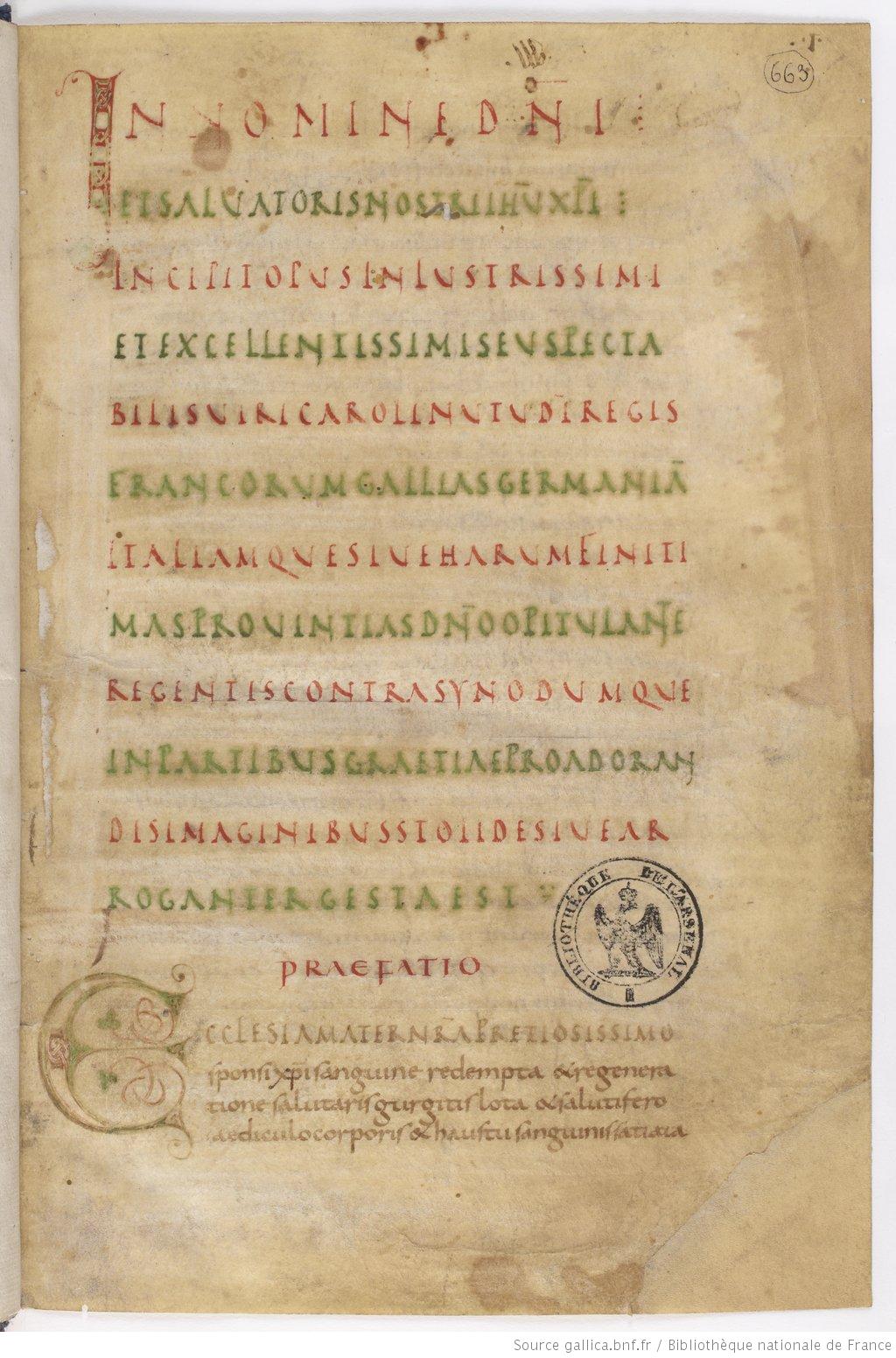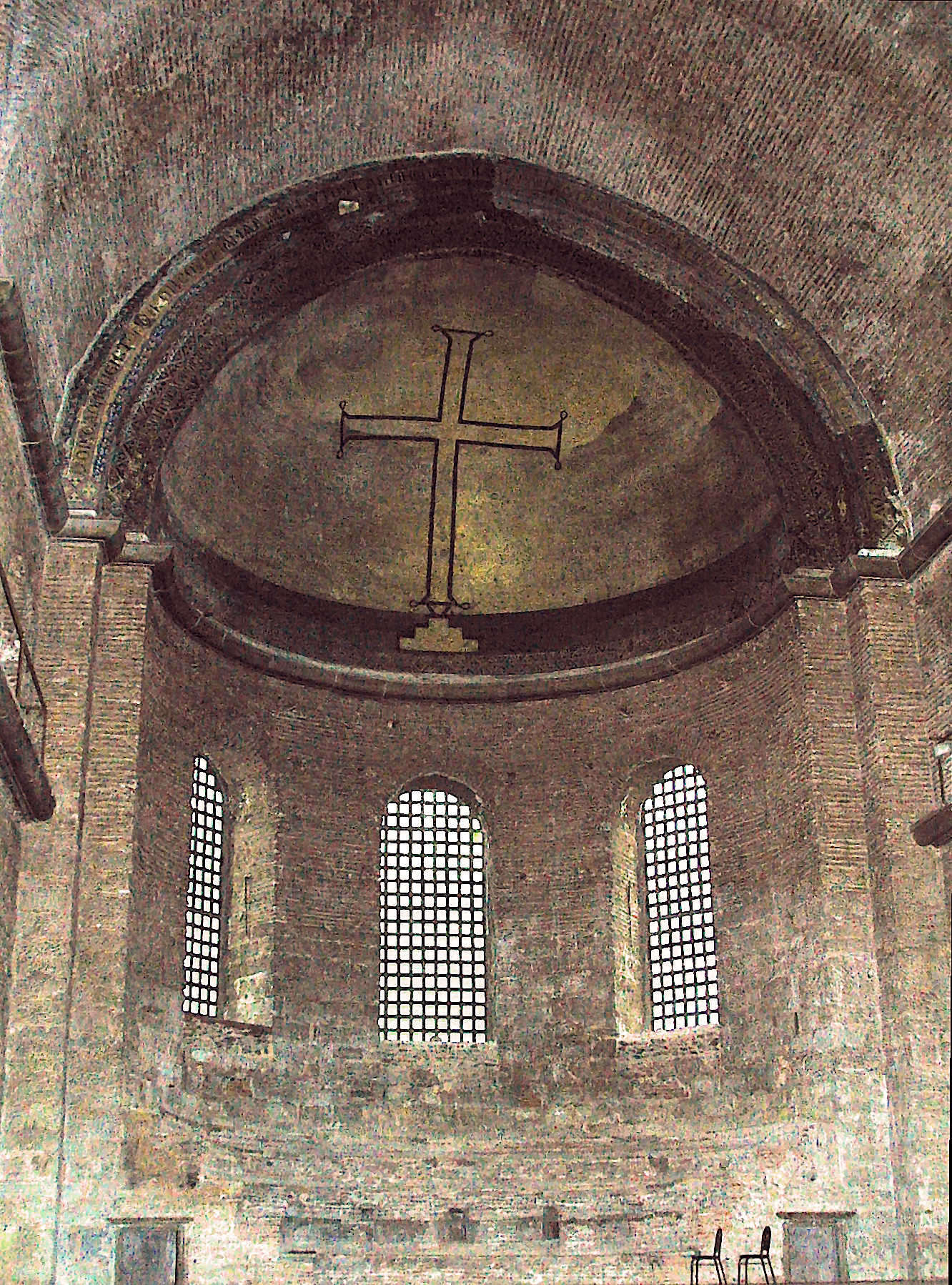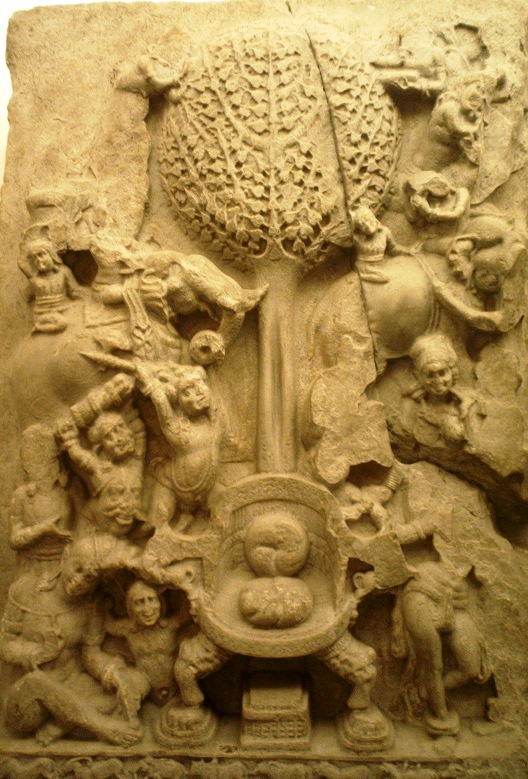|
Libri Carolini
The ''Libri Carolini'' ("Charles' books"), more correctly ''Opus Caroli regis contra synodum'' ("The work of King Charles against the Synod"), is a work in four books composed on the command of Charlemagne in the mid 790s to refute the conclusions of the Byzantine Second Council of Nicaea (787), particularly as regards the matter of sacred images. They are "much the fullest statement of the Western attitude to representational art that has been left to us by the Middle Ages". Two earlier Frankish tracts against images (known in conjunction as the ''Capitulare adversus synodum'') had been sent in 792 to Pope Hadrian I, who had replied with an attempt at a refutation. The ''Libri Carolini'' was then composed as a fuller rebuttal of Hadrian's position. But Charlemagne realized that further controversy with Rome would serve no purpose, and the work was never sent. It remained unknown until it was published by Jean du Tillet in 1549, in the very different context of the debates over ... [...More Info...] [...Related Items...] OR: [Wikipedia] [Google] [Baidu] |
Gospel Of John
The Gospel of John () is the fourth of the New Testament's four canonical Gospels. It contains a highly schematic account of the ministry of Jesus, with seven "Book of Signs, signs" culminating in the raising of Lazarus (foreshadowing the resurrection of Jesus) and seven "I am (biblical term), I am" discourses (concerned with issues of the Split of early Christianity and Judaism, church–synagogue debate at the time of composition) culminating in Thomas the Apostle, Thomas's proclamation of the risen Jesus as "my Lord and my God". The penultimate chapter's concluding verse set out its purpose, John 20:31, "that you may believe that Jesus is the Christ, the Son of God, and that believing you may have life in his name." John reached its final form around AD 90–110, although it contains signs of origins dating back to AD 70 and possibly even earlier. Like the three other gospels, it is anonymous, although it identifies an unnamed "disciple whom Jesus loved" as the source o ... [...More Info...] [...Related Items...] OR: [Wikipedia] [Google] [Baidu] |
Manuscripts In The Vatican Library
A manuscript (abbreviated MS for singular and MSS for plural) was, traditionally, any document written by hand or typewritten, as opposed to mechanically printed or reproduced in some indirect or automated way. More recently, the term has come to be understood to further include ''any'' written, typed, or word-processed copy of an author's work, as distinguished from the rendition as a printed version of the same. Before the arrival of prints, all documents and books were manuscripts. Manuscripts are not defined by their contents, which may combine writing with mathematical calculations, maps, music notation, explanatory figures, or illustrations. Terminology The word "manuscript" derives from the (from , hand and from , to write), and is first recorded in English in 1597. An earlier term in English that shares the meaning of a handwritten document is "hand-writ" (or "handwrit"), which is first attested around 1175 and is now rarely used. The study of the writing (the ... [...More Info...] [...Related Items...] OR: [Wikipedia] [Google] [Baidu] |
8th-century Books In Latin
The 8th century is the period from 701 (represented by the Roman numerals DCCI) through 800 (DCCC) in accordance with the Julian Calendar. In the historiography of Europe the phrase the long 8th century is sometimes used to refer to the period of circa AD 660–820. The coast of North Africa and the Iberian Peninsula quickly came under Islamic Arab domination. The westward expansion of the Umayyad Empire was famously halted at the siege of Constantinople by the Byzantine Empire and the Battle of Tours by the Franks. The tide of Arab conquest came to an end in the middle of the 8th century.Roberts, J., '' History of the World'', Penguin, 1994. In Europe, late in the century, the Vikings, seafaring peoples from Scandinavia, begin raiding the coasts of Europe and the Mediterranean, and go on to found several important kingdoms. In Asia, the Pala Empire is founded in Bengal. The Tang dynasty reaches its pinnacle under Chinese Emperor Xuanzong. The Nara period begins in Jap ... [...More Info...] [...Related Items...] OR: [Wikipedia] [Google] [Baidu] |
8th-century Christian Texts
The 8th century is the period from 701 (represented by the Roman numerals DCCI) through 800 (DCCC) in accordance with the Julian Calendar. In the historiography of Europe the phrase the long 8th century is sometimes used to refer to the period of circa AD 660–820. The coast of North Africa and the Iberian Peninsula quickly came under Islamic Arab domination. The westward expansion of the Umayyad Empire was famously halted at the siege of Constantinople by the Byzantine Empire and the Battle of Tours by the Franks. The tide of Arab conquest came to an end in the middle of the 8th century.Roberts, J., '' History of the World'', Penguin, 1994. In Europe, late in the century, the Vikings, seafaring peoples from Scandinavia, begin raiding the coasts of Europe and the Mediterranean, and go on to found several important kingdoms. In Asia, the Pala Empire is founded in Bengal. The Tang dynasty reaches its pinnacle under Chinese Emperor Xuanzong. The Nara period begins in J ... [...More Info...] [...Related Items...] OR: [Wikipedia] [Google] [Baidu] |
Catholic Theology And Doctrine
The Catholic Church (), also known as the Roman Catholic Church, is the largest Christian church, with 1.27 to 1.41 billion baptized Catholics worldwide as of 2025. It is among the world's oldest and largest international institutions and has played a prominent role in the history and development of Western civilization. O'Collins, p. v (preface). The church consists of 24 ''sui iuris'' (autonomous) churches, including the Latin Church and 23 Eastern Catholic Churches, which comprise almost 3,500 dioceses and eparchies around the world, each overseen by one or more bishops. The pope, who is the bishop of Rome, is the chief pastor of the church. The core beliefs of Catholicism are found in the Nicene Creed. The Catholic Church teaches that it is the one, holy, catholic and apostolic church founded by Jesus Christ in his Great Commission, that its bishops are the successors of Christ's apostles, and that the pope is the successor of Saint Peter, upon whom ... [...More Info...] [...Related Items...] OR: [Wikipedia] [Google] [Baidu] |
Byzantine Iconoclasm
The Byzantine Iconoclasm () are two periods in the history of the Byzantine Empire when the use of religious images or icons was opposed by religious and imperial authorities within the Ecumenical Patriarchate (at the time still comprising the Roman-Latin and the Eastern-Orthodox traditions) and the temporal imperial hierarchy. The First Iconoclasm, as it is sometimes called, occurred between about 726 and 787, while the Second Iconoclasm occurred between 814 and 842. According to the traditional view, Byzantine Iconoclasm was started by a ban on religious images promulgated by the Byzantine Emperor Leo III the Isaurian, and continued under his successors. It was accompanied by widespread destruction of religious images and persecution of supporters of the veneration of images. The Papacy remained firmly in support of the use of religious images throughout the period, and the whole episode widened the East–West Schism, growing divergence between the Byzantine and Carolingian Em ... [...More Info...] [...Related Items...] OR: [Wikipedia] [Google] [Baidu] |
Aniconism
Aniconism is the cultural absence of artistic representations ('' icons'') of the natural and supernatural worlds, or it is the absence of representations of certain figures in religions. The prohibition of material representations may only extend to a specific supreme deity, or it can encompass an entire pantheon, it can also include depictions of a prophet, saints, or sages, or even depictions of living beings and anything in existence generally. It is generally codified by religious traditions and as such, it becomes a taboo. When it is enforced by the physical destruction of images, aniconism becomes iconoclasm. Aniconism has historical phases in both Buddhism and Christianity, though these movements have been largely rejected as Buddha in art, life of Buddha in art, Buddhas and bodhisattvas in art, God the Father in Western art, Holy Spirit in Christian art, the depiction of Jesus, The Trinity in art, and are common. By contrast Aniconism in Islam, Islam has predomin ... [...More Info...] [...Related Items...] OR: [Wikipedia] [Google] [Baidu] |
Carolingian Latin Literature
The Carolingian dynasty ( ; known variously as the Carlovingians, Carolingus, Carolings, Karolinger or Karlings) was a Frankish noble family named after Charles Martel and his grandson Charlemagne, descendants of the Arnulfing and Pippinid clans of the 7th century AD. The dynasty consolidated its power in the 8th century, eventually making the offices of mayor of the palace and '' dux et princeps Francorum'' hereditary, and becoming the ''de facto'' rulers of the Franks as the real powers behind the Merovingian throne. In 751 the Merovingian dynasty which had ruled the Franks was overthrown with the consent of the Papacy and the aristocracy, and Pepin the Short, son of Martel, was crowned King of the Franks. The Carolingian dynasty reached its peak in 800 with the crowning of Charlemagne as the first Emperor of the Romans in the West in over three centuries. Nearly every monarch of France from Charlemagne's son Louis the Pious until the penultimate monarch of France Louis Phi ... [...More Info...] [...Related Items...] OR: [Wikipedia] [Google] [Baidu] |
Zeitschrift Für Katholische Theologie
The ''Zeitschrift für katholische Theologie'' was a quarterly peer-reviewed academic journal established in 1877 at the Faculty of Theology at the University of Innsbruck. It was associated with the Society of Jesus. The journal published its last independent issue in 2020. With the beginning of 2021 the journal merged with the journal ''Theologie und Philosophie'' to form the ''Zeitschrift für Theologie und Philosophie''. The journal aims to promote ecumenical discussion in the spirit of the Second Vatican Council. It is accessible through JSTOR and abstracted and indexed in the ATLA Religion Database and Scopus Scopus is a scientific abstract and citation database, launched by the academic publisher Elsevier as a competitor to older Web of Science in 2004. The ensuing competition between the two databases has been characterized as "intense" and is c .... References External links * German-language journals Jesuit publications Publications established in 1877 Qua ... [...More Info...] [...Related Items...] OR: [Wikipedia] [Google] [Baidu] |
Index Librorum Prohibitorum
The (English: ''Index of Forbidden Books'') was a changing list of publications deemed heretical or contrary to morality by the Sacred Congregation of the Index (a former dicastery of the Roman Curia); Catholics were forbidden to print or read them, subject to the local bishop. The Holy Office justified that decision by referring to chapter 13 of Paul the Apostle's Epistle to the Romans regarding state authority coming from God. However, somewhat later, the Vatican criticized in the encyclical (March 1937) about the challenges of the church in Nazi Germany. Abolition (1966) On 7 December 1965, Pope Paul VI issued the that reorganized the Holy Office as the ''Sacred Congregation for the Doctrine of the Faith''. The Index was not listed as being a part of the newly constituted congregation's competence, leading to questioning whether it still was. This question was put to Cardinal Alfredo Ottaviani, pro-prefect of the congregation, who responded in the negative. The Cardinal ... [...More Info...] [...Related Items...] OR: [Wikipedia] [Google] [Baidu] |
Protestant Reformation
The Reformation, also known as the Protestant Reformation or the European Reformation, was a time of major theological movement in Western Christianity in 16th-century Europe that posed a religious and political challenge to the papacy and the authority of the Catholic Church. Towards the end of the Renaissance, the Reformation marked the beginning of Protestantism. It is considered one of the events that signified the end of the Middle Ages and the beginning of the early modern period in Europe. The Reformation is usually dated from Martin Luther's publication of the '' Ninety-five Theses'' in 1517, which gave birth to Lutheranism. Prior to Martin Luther and other Protestant Reformers, there were earlier reform movements within Western Christianity. The end of the Reformation era is disputed among modern scholars. In general, the Reformers argued that justification was based on faith in Jesus alone and not both faith and good works, as in the Catholic view. In the ... [...More Info...] [...Related Items...] OR: [Wikipedia] [Google] [Baidu] |







